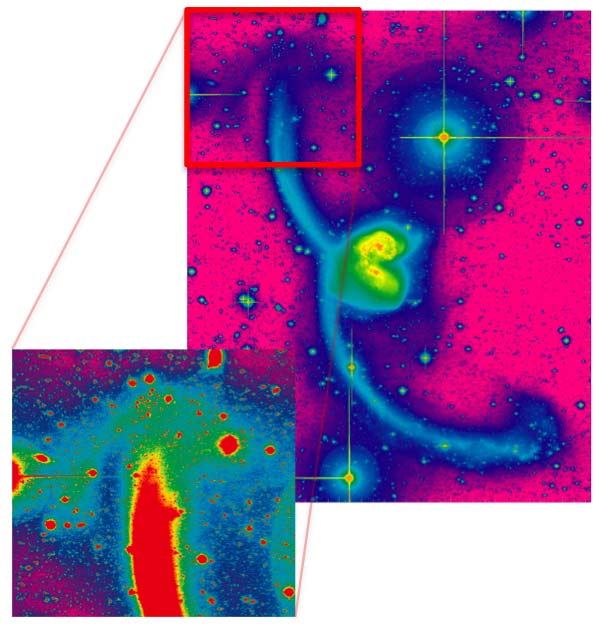Galactic Collisions Leave Cosmic Skid Marks

PASADENA, CALIF. ? Cosmic debris stripped away fromthe wreck of colliding galaxies has been found by the Subaru telescope atop Mauna Kea, Hawaii.
The debrisfields could shed light on galaxy formation and starburst activity in the earlyuniverse by allowing astronomers to retrace the paths of the collidinggalaxies before they merged.
"Thisis equivalent to finally being able to trace the skid marks on the road wheninvestigating a car wreck," said team member Nick Scoville of theCalifornia Institute of Technology.
Enormousdebris fields found
Astronomersfound the debris features in deep exposures of well-known colliding galaxies,including "the Antennae" galaxies,?65 million light-years away inthe constellation Corvus, Arp 220 in the constellation Serpens (250 millionlight-years away), Mrk 231 in the Big Dipper (590 million light-years away),and 10 other objects. (A light year is the distance that light travels in ayear, about 6 trillion miles or 10 trillion kilometers.)
The extentof the debris, some of which stretched over an area a few times larger than theMilky Way, hadn't been seen in earlier images of these collisions, astronomerssaid. A large extension of the Antennae was found to be twice the sizepreviously thought, and a new tidal tail was found trailing from Mrk 231.
"Wedid not expect such enormous debris fields around these famous objects,"said team member Jin Koda of Stony Brook University in New York.
Breaking space news, the latest updates on rocket launches, skywatching events and more!
Thediscoveries were announced here today at the 214th meeting of the AmericanAstronomical Society.
Tidaltails
Collidinggalaxies eventually merge and become a single galaxy. Our own Milky Way is fatedto collide and merge with the neighboring Andromeda galaxy in about 5billion years.
The mutualtug the galaxies exert on each other can pull pieces of each galaxy out indifferent shapes.
One exampleis so-called "tidal tails," which indicate a quick galactic merger.When galaxies come together quickly, they could trigger starburst activity inUltra Luminous Infrared Galaxies (ULIRGs).
"Arp220 is the most famous ULIRG," said team member Yoshiaki Taniguchi of Ehime University in Japan. "ULIRGs are very likely the dominant mode of cosmic starformation in the early Universe, and Arp 220 is the key object to understandstarburst activities in ULIRGs."
- Video? Galaxy Collisions
- Video? The Biggest Cosmic Collisions
- HubblePhotos: When Galaxies Collide
Join our Space Forums to keep talking space on the latest missions, night sky and more! And if you have a news tip, correction or comment, let us know at: community@space.com.

Andrea Thompson is an associate editor at Scientific American, where she covers sustainability, energy and the environment. Prior to that, she was a senior writer covering climate science at Climate Central and a reporter and editor at Live Science, where she primarily covered Earth science and the environment. She holds a graduate degree in science health and environmental reporting from New York University, as well as a bachelor of science and and masters of science in atmospheric chemistry from the Georgia Institute of Technology.
